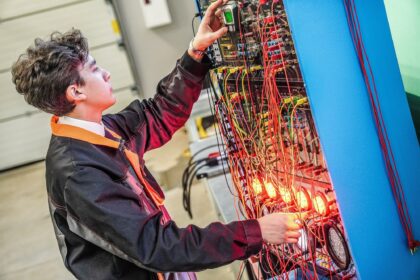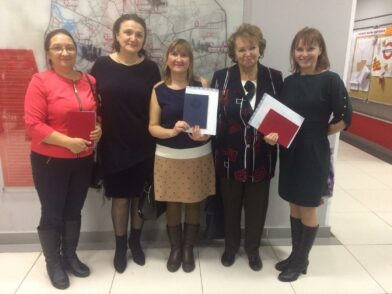Долгие годы при обучении иностранному языку в школе упор делался на чтение и перевод. Лишь в первой половине 90-х годов в нормативных документах Министерства образования было записано, что цель школьного курса иностранного языка √ “формирование коммуникативной компетенции”. Это значит, что задача школы √ учить языку так, чтобы ребята могли применить свои знания не только для ответа на уроке, но и в любой жизненной ситуации.
Безусловно, форма экзамена влияет на качество преподавания. К сожалению, переводные и выпускные экзамены во многих школах остались практически без изменений. Они по-прежнему включают в себя “топики”, чтение, перевод, пересказ. Ученики иногда просто заучивают “топики”, даже не понимая содержания отдельных фраз. Конечно, обучение монологическим высказываниям необходимо, но это обучение должно носить прикладной характер и сочетаться с другими видами речевой деятельности, с обучением ораторскому искусству. Например, дебаты по заданной теме требуют владения этими навыками.
Наша школа уже три года успешно работает над разработкой и апробацией новых проектов итоговой аттестации. Целью итоговой аттестации по первому иностранному языку является установление соответствия между реальным уровнем сформированности коммуникативной компетенции у учащихся и теми требованиями, которые обозначены в “Программе обучения иностранным языкам учащихся школ с углубленным изучением иностранных языков” в отношении видов речевой деятельности и социокультурного развития школьников.
Проект итоговой аттестации, который разработан в нашей школе и соавтором которого я являюсь, состоит из двух частей.
1. Комплексный дифференцированный зачет.
А. Коммуникативно-ориентированное задание √ создание и защита проектной работы.
Учащиеся должны продемонстрировать умение выступить с сообщением о результатах работы над письменным проектом, показать социокультурную и страноведческую осведомленность, выбрать из справочной литературы необходимую информацию, интерпретировать ее, логично изложить, сделать выводы и аргументировать их устно.
Работа прежде всего должна отражать индивидуальность ученика, его собственный взгляд на окружающий мир, его способность критически оценить новую информацию, аргументированно и логично изложить свою точку зрения. В течение двух лет обучения в старшей школе учащиеся неоднократно проводят групповые и индивидуальные исследовательские работы. Часто эти работы носят межпредметный характер. Значение межпредметных связей чрезвычайно велико прежде всего потому, что знания по одному предмету служат основой для сознательного усвоения знаний по другому. С другой стороны, система межпредметных связей обеспечивает многосторонний подход к изучаемым объектам и явлениям реальной действительности и способствует построению в сознании учащихся целостной системы мира. Ребята под руководством научного руководителя (учителя) учатся формулировать учебные задачи, выдвигать гипотезы, обрабатывать большие массивы информации, сопоставлять данные делать выводы. Они познают сложную науку работы в группе, приобретают навыки сотрудничества и делового общения.
В прошлом году мои ученики выполняли творческие проекты в форме интервью, видеофильма, журнала, брошюры, эссе. Темы творческих проектов: “Имидж как фактор достижения успеха”, “Создание социальной некоммерческой рекламы, направленной на защиту окружающей среды и пропаганду здорового образа жизни”, “Создание информационно-развлекательного молодежного журнала”, “Влияние СМИ на политические и социальные явления”, “Современные молодежные объединения √ за и против”, “Мировая интеграция и устранение границ” и др.
На итоговом зачете было предложено написать философское эссе на темы: “The most important things in life” (“Самое главное в твоей жизни”), “National stereotypes. Do they help or mislead us?” (“Национальные стереотипы: помогают или дезориентируют?”).
Большим достоинством творческих проектов является то, что они предусматривают взаимосвязь всех четырех видов речевой деятельности. Защита проектов происходит на “круглых столах”, в открытых дискуссиях, дебатах.
Б. Лексико- грамматический тест (чтение, аудирование, письмо).
Коммуникативно-ориентированные задания с множественным выбором, на заполнение пропусков, на написание письма и др.
2. Экзамен
А. Чтение аутентичного текста с извлечением полной информации.
Коммуникативно√ориентированные задания на обсуждение и интерпретацию прочитанного текста. Учащиеся демонстрируют умение определять основную идею, проблему, выделять главные и второстепенные факты, сравнивать их, делать выводы, аргументировать свою точку зрения.
Мы выбирали неадаптированные художественные и публицистические тексты из различных современных источников (“Readers Digest”, “Times” и др.).
Б. Устная речь (говорение и аудирование).
Коммуникативно-ориентированное задание – обсуждение предложенной проблемы с аргументацией собственной точки зрения.
В прошлом году ребятам были предложены высказывания известных людей, затрагивающие актуальные для человечества нравственные, духовные, социально значимые вопросы (дружба, любовь, семья, чувство долга и патриотизма, благородство, честь, образование и т.п.). Высказывания подбирались в соответствии с проблематикой текста.
Практика показывает, что учащиеся, проявляя высокий уровень языковой и социокультурной компетенции, относятся к экзамену творчески, ответственно и заинтересованно. Такая форма экзамена стимулирует мотивационную сферу учащегося, способствует наиболее полному раскрытию личности и потенциала школьника.
Ниже предложен один из вариантов экзаменационных билетов:
A Gift Of Dreams
By George H. Brooks.
Christmas Eve, 1944. I was a sailor in the U.S. Navy, on a one-day leave in San Francisco. I had won $300 at poker that ordinarily would have burnt a hole in my pocket, but I could shake an overwhelming sadness. I▓d just received word that another friend had been killed in Europe. And here I was, an 18-year-old alone in a strange city. Nothing seemed to make any kind of sense. What was I going to be fighting for, anyway?
I spent most of the day in a mental fog, wandering aimlessly through crowds of laughing, happy people. Then, late in the afternoon, my vision suddenly focused, and for the first time a scene registered. There in a department-store window were two electric trains chugging through a miniature, snow-covered town. In front of the window was a skinny boy around nine years old, his nose pressed against the glass. He just stood there, fixed on those trains. Suddenly the boy was me nine short years before, and the store was Macy▓s in New York City, my hometown. I could see, could feel the same longing, the same desperate hoping. I could hear the sigh of resignation – the frail attempt to hide the disappointment that Dad could not afford those trains. And I saw the reluctant turning away and then the one last look. Not this time! I don▓t know what came over me, but I grabbed the boy by the arm, scaring him half to death.
“My name is George,” I told him.
“Jeffrey Hollis Jr.,” he managed to reply.
“Well, Jeff Hollis Jr.,” I said in my best grown-up voice, “we are going to get us those trains.”
His eyes grew wide, and he let me lead him into the store. I knew it was crazy, but I didn▓t care. Suddenly I wanted to be nine again and have a kid▓s dream come true. The salesclerk looked at us suspiciously, a scruffy boy and a sailor in ill-fitting dress blue.
“Those trains in the window,” I blurted before he could speak. “The whole setup. How much is it?”
His snorting response was interrupted by the arrival of a much older man wearing a warm Christmas smile. “One hundred and sixty-five dollars and sixty-three cents,” the elder man replied, “delivery included.”
“We▓ll take it”, I said. “Right now, if we can.”
“Sailor,” he said “we can! What about the rest of the family?”
I leaned down, and Jeff Jr. Whispered that he had two little sisters as well as his mom and pop. I gave him $50.
Jeff Hollis Sr.▓s reaction reminded me of what my own father▓s would have been if I had shown up with a stranger a whole lot of gifts. I could see he was a hard-working man, breaking his back to make ends meet and knowing he couldn▓t give his family all he wanted.
“I▓m just a sailor a long way from home, Mr. Hollis,” I said respectfully, explaining how I had seen myself in his son▓s longing gaze at the store display.
“You couldn▓t have spent the money any other way?” he asked gruffly.
“No, sir,” I replied.
His face softened, and he welcomed me to share their table. After supper, I read to Jeff and his sisters until they went off to bed. Then I joined Mr. Hollis at what turned out to be nearly all-night job of getting the trains put together and set up. At midnight we paused to wish each other a Merry Christmas, then back to the task of making a boy▓s dream come true. When we finished, I was bone-tired. I guess I dozed because the next thing I knew it was five o▓clock, and Jeff was shaking me. I exchanged glances with his father: this was the honoured, official, first outing. With Jeff at one control and me at the other, we set the trains on their way. For about five minutes he ran his train. Then, abruptly, he stopped and, without a word, left the room. He returned with the presents he bought, a look of pride on his face. He▓d had some help, but he▓d made the choices himself. I thought he was finished when he turned to me with a package in his hand. I was totally surprised. The gift was a comb-and-a brush set. He held out his hand, then changed his mind and hugged me warmly.
As I made my way to the station to catch a bus back to the base, I realized I had no more nagging doubts. I had found more in this experience than I had received from all the pep talks and patriotic speeches I had ever heard.
For me, it was a revelation. I knew now what this war and all the fighting was about. It was something at once wonderful and simple. This country, my country, was a place of dreams… and of dreamers who had the faith and the will to make dreams come true.
Card N 1.
I. Read the text and answer the questions:
1. Why did George decide to make a boy▓s dream come true? How do you understand the words “A Gift of Dreams”? Does everyone have such a Gift?
2. What did the author realize by the end of the story?
II. Comment on the following:
“Good actions ennoble us and we are the sons of our deeds”. (Cervantes).
Ancient Beauty Queen Returns Home
By Robin Young.
The sculptured head of Ancient Egypt▓s most beautiful Queen, dating from the 13th century BC, was returned to the Egyptian Government yesterday after the British Museum provided evidence proving that it had been stolen and smuggled to Britain in the early 1990s.
The sculpture, known as the Head of Meryet, is thought to be almost certainly a representation of Nefertari, the renewed beauty and principal queen of Rameses II whose name meant “beautiful lady”.
The piece was traced to the Devon studio of an antiques restorer who specialized in smuggling and disguising Egyptian antiquities. It had been brought out of Egypt painted blue and gold to resemble the reproduction tourist souvenirs offered in many Cairo shops.
The hieroglyphic inscription identifying the piece was then chipped away and replaced with a false inscription copied from photographs taken in a Cairo museum, and stone drilled from the core of the sculpture was ground down to provide material to reconstruct a new face over the damaged original.
When the smuggling ring was exposed in 1997, and the ringleader sentenced to six years▓ imprisonment, the Egyptian Government sought the return of piece from the owner, who had bought it from the smuggler, but was met with the claim that the head was a complete fake and not a genuine antiquity at all. At the request of the Egyptian Government and its legal representatives, experts from the British Museum▓s Department of Egyptian Antiquities examined the sculpture in detail.
Ken Uprichard, head of the stone conservation section at the museum, said: “It took only four hours▓ examination to conclude that the piece was genuine and to identify what had been done to alter its appearance. There were suspicious lines around the face and neck apparent even to the naked eye, and under the microscope it was even more obvious that these were made up of very small pieces of stone set in an adhesive.”
Robert Andersen, director of the British Museum, said at a ceremony in his office yesterday: “We are delighted to have played a part in the return of this sculpture to Egypt. We have excellent relations with the Egyptian Government and continue to enjoy collaboration through excavation, conservation, training and the sharing of knowledge.”
Vivian Davies, keeper of the Department of the Egyptian Antiquities, said that the museum could not put a market value on the piece, but added: “It would certainly be very substantial. We are confident from stylistic evidence and the presence of a snake motif, which is otherwise known only from Nefertari▓s tomb at Luxor, that this is part not only of ancient and major votive statue, but that it represents Queen Nefertari herself, the chief queen of Rameses II and a “very important figure.”
The museum▓s evidence proved conclusive in enabling the Egyptian Government▓s representatives to negotiate an agreement with the head▓s native owner, whose identity has not been disclosed. It will now be up to the Egyptian authorities to decide what should be done with the head, but Mr. Davies said: “It is my personal view that would be worth removing the modern remodelled face, even though there is a hole beneath it. That would restore the piece as closely as possible to the appearance it had before it was stolen and tampered with.”
Adel El-Gazzar, the Egyptian Ambassador, who accepted the piece on behalf of his Government, said: “This handover is a manifestation of the mutual co-operation between our two Governments and their fight against the illegal and sinister trade in stolen cultural artifacts.
In answer to a question, Dr Anderson said the case of the Head of Meryet bore no parallels to that of the Elgin Marbles, for whose return the Greek Government has advanced claims. “The marbles from the Parthenon were brought to Britain by Lord Elgin as an act of conservation,” Dr Anderson said, adding: “All our Egyptian exhibits were legally acquired as well.”
One further piece of Egyptian statuary still the subject of legal dispute in the wake of the smuggling exposure remains in the safe-keeping of the British Museum pending the outcome of court proceedings. That is a head of King Amenhotep III, which has not been altered or restored.
Card N 9.
I. Read the text and answer the questions:
1. Why was it important to return the sculptured head of Ancient Egypt▓s most beautiful Queen to the place of its origin?
2. Do you think art treasures should be kept in their places of origin? What are the advantages of exhibiting the art treasures in major cities?
II. Comment on the following:
“Science and art belong to the whole world, and before them vanish the barriers of nationality”. (Goethe).
Татьяна АРХИПОВА







 Выбор читателей
Выбор читателей







Комментарии